Lower Manhattan
Lower Manhattan
Downtown Manhattan | |
|---|---|
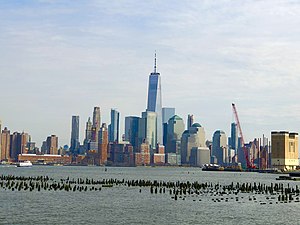 The new One World Trade Center dominating the Lower Manhattan, seen from Hoboken in 2019 | |
 Location of Lower Manhattan | |
| Country | |
| State | |
| City | New York City |
| Borough | Manhattan |
| Population (2010) | |
| • Total | 382,654 |
| ZIP Codes | 10004, 10005, 10006, 10007, 10038, 10280, 10012, 10013, 10014 |
| Area code(s) | 212, 332, 646, and 917 |
| Median household income | $201,953 |
Lower Manhattan, also known as Downtown Manhattan or Downtown New York, is the southernmost part of Manhattan, the central borough for business, culture, and government in New York City. Lower Manhattan is defined most commonly as the area delineated on the north by 14th Street, on the west by the Hudson River, on the east by the East River, and on the south by New York Harbor (also known as Upper New York Bay). The Lower Manhattan business district, known as the Financial District, forms the core of the area below Chambers Street.
The city had itself originated at the southern tip of Manhattan Island in 1624,[1] at a point that now constitutes the present-day Financial District. The population of the Financial District alone has grown to an estimated 61,000 residents as of 2018,[2] up from 43,000 as of 2014, which in turn was nearly double the 23,000 recorded at the 2000 Census.[3]
Geography

Lower Manhattan is defined most commonly as the area delineated on the north by 14th Street, on the west by the Hudson River, on the east by the East River, and on the south by New York Harbor (also known as Upper New York Bay). When referring specifically to the Lower Manhattan business district and its immediate environs, the northern border is commonly designated by thoroughfares about a mile-and-a-half south of 14th Street and a mile north of the island's southern tip: approximately around Chambers Street from near the Hudson east to the Brooklyn Bridge entrances and overpass.[4] Two other major arteries are also sometimes identified as the northern border of "Lower" or "Downtown Manhattan": Canal Street, roughly half a mile north of Chambers Street, and 23rd Street, roughly half a mile north of 14th Street.
The Lower Manhattan business district forms the core of the area below Chambers Street. It includes the Financial District (often referred to as Wall Street, after its primary artery) and the World Trade Center site. At the island's southern tip is Battery Park; City Hall is just to the north of the Financial District. Also south of Chambers Street are the planned community of Battery Park City and the South Street Seaport historic area. The neighborhood of TriBeCa straddles Chambers Street on the west side; at the street's east end is the giant Manhattan Municipal Building. North of Chambers Street and the Brooklyn Bridge and south of Canal Street lies most of New York's oldest Chinatown neighborhood. Many court buildings and other government offices are also located in this area. The Lower East Side neighborhood straddles Canal Street. North of Canal Street and south of 14th Street are the neighborhoods of SoHo, the Meatpacking District, the West Village, Greenwich Village, Little Italy, Nolita, and the East Village. Between 14th and 23rd streets are lower Chelsea, Union Square, the Flatiron District, as well as Gramercy, with the large residential development known as Peter Cooper Village—Stuyvesant Town situated on the eastern flank of this zone.
History
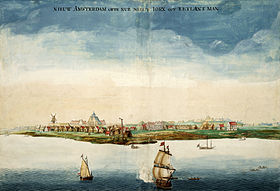
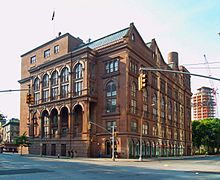

Lenape and New Netherland
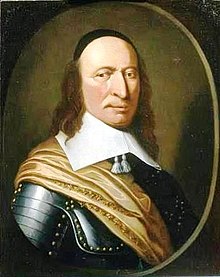
The area that would eventually encompass modern-day New York City was inhabited by the Lenape people. These groups of culturally and linguistically identical Native Americans traditionally spoke an Algonquian language now referred to as Unami.
European settlement began with the founding of a Dutch fur trading post in Lower Manhattan, later called New Amsterdam (Dutch: Nieuw-Amsterdam) in 1626.[5][6] The first fort was built at The Battery to protect New Netherland.[7]
Soon thereafter, most likely in 1626, construction of Fort Amsterdam began.[7] Later, the Dutch West Indies Company imported African slaves to serve as laborers; they helped to build the wall that defended the town against English and native attacks. Early directors included Willem Verhulst and Peter Minuit. Willem Kieft became a director in 1638 but five years later was embroiled in Kieft's War against the Native Americans. The Pavonia Massacre, across the Hudson River in present-day Jersey City resulted in the death of 80 natives in February 1643. Following the massacre, Algonquian tribes joined forces and nearly defeated the Dutch. The Dutch Republic sent additional forces to the aid of Kieft, leading to the overwhelming defeat of the Native Americans and a peace treaty on August 29, 1645.[8]: 37–40
On May 27, 1647, Peter Stuyvesant was inaugurated as director general upon his arrival. The colony was granted self-government in 1652, and New Amsterdam was formally incorporated as a city on February 2, 1653.[8]: 57 The first mayors (burgemeesters) of New Amsterdam, Arent van Hattem and Martin Cregier, were appointed in that year.[9]
17th and 18th centuries
In 1664, the English conquered the area and renamed it "New York" after the Duke of York and the city of York in Yorkshire.[10][11]
At that time, people of African descent made up 20% of the population of the city, with European settlers numbering approximately 1,500,[12]: 14 and people of African descent numbering 375 (with 300 of that 375 enslaved and 75 free).[12]: 22 While it has been claimed that African slaves comprised 40% of the small population of the city at that time,[13] this claim has not been substantiated. During the mid 1600s, farms of free blacks covered 130 acres (53 ha) where Washington Square Park later developed.[14]
The Dutch briefly regained the city in 1673, renaming the city "New Orange", before permanently ceding the colony of New Netherland to the English for what is now Suriname in November 1674.
The new English rulers of the formerly Dutch New Amsterdam and New Netherland renamed the settlement back to New York. As the colony grew and prospered, sentiment also grew for greater autonomy. In the context of the Glorious Revolution in England, Jacob Leisler led Leisler's Rebellion and effectively controlled the city and surrounding areas from 1689–1691, before being arrested and executed.
By 1700, the Lenape population of New York had diminished to 200.[15] By 1703, 42% of households in New York had slaves, a higher percentage than in Philadelphia or Boston.[16]
The 1735 libel trial of John Peter Zenger in the city was a seminal influence on freedom of the press in North America. It would be a standard for the basic articles of freedom in the United States Declaration of Independence.

By the 1740s, with expansion of settlers, 20% of the population of New York were slaves, totaling about 2,500 people.[17] After a series of fires in 1741, the city became panicked that blacks planned to burn the city in a conspiracy with some poor whites. Historians believe their alarm was mostly fabrication and fear, but officials rounded up 31 blacks and 4 whites, all of whom were convicted of arson and executed. City officials executed 13 blacks by burning them alive and hanged 4 whites and 18 blacks.[18]
In 1754, Columbia University was founded under charter by George II of Great Britain as King's College in Lower Manhattan.[19]
The Stamp Act and other British measures fomented dissent, particularly among the Sons of Liberty, who maintained a long-running skirmish with locally stationed British troops over Liberty Poles from 1766 to 1776. The Stamp Act Congress met in New York City in 1765 in the first organized resistance to British authority across the colonies. After the major defeat of the Continental Army in the Battle of Long Island, General George Washington withdrew to Manhattan Island, but with the subsequent defeat at the Battle of Fort Washington the island was effectively left to the British. The city became a haven for loyalist refugees, becoming a British stronghold for the entire war. Consequently, the area also became the focal point for Washington's espionage and intelligence-gathering throughout the war.
In 1771, Bear Market was established along the Hudson River shoreline on land donated by Trinity Church, and replaced by Washington Market in 1813.[20]
New York City was greatly damaged twice by fires of suspicious origin during British military rule. The city became the political and military center of operations for the British in North America for the remainder of the war and a haven for Loyalist refugees. Continental Army officer Nathan Hale was hanged in Manhattan for espionage. In addition, the British began to hold the majority of captured American prisoners of war aboard prison ships in Wallabout Bay, across the East River in Brooklyn. More Americans lost their lives from neglect aboard these ships than died in all the battles of the war. British occupation lasted until November 25, 1783. George Washington triumphantly returned to the city that day, as the last British forces left the city.
Starting in 1785, the Congress met in New York City under the Articles of Confederation. In 1789, New York City became the first national capital of the United States under the new United States Constitution. The Constitution also created the current Congress of the United States, and its first sitting was at Federal Hall on Wall Street. The first United States Supreme Court sat there. The United States Bill of Rights was drafted and ratified there. George Washington was inaugurated at Federal Hall.[21] New York City remained the capital of the U.S. until 1790, when the role was transferred to Philadelphia.
19th century

New York grew as an economic center, first as a result of Alexander Hamilton's policies and practices as the first Secretary of the Treasury and, later, with the opening of the Erie Canal in 1825, which connected the Atlantic port to the vast agricultural markets of the North American interior.[22][23] Immigration resumed after being slowed by wars in Europe, and a new street grid system, the Commissioners' Plan of 1811, expanded to encompass all of Manhattan. Early in the 19th century, the landfill was used to expand Lower Manhattan from the natural Hudson shoreline at Greenwich Street to West Street.[24]
In 1898, the modern City of New York was formed with the consolidation of Brooklyn (until then an independent city), Manhattan and outlying areas.[25] The borough of Brooklyn incorporated the independent City of Brooklyn, recently joined to Manhattan by the Brooklyn Bridge in Lower Manhattan. Municipal governments contained within the boroughs were abolished, and the county governmental functions, housed in Lower Manhattan after unification, were absorbed by the City or each borough.[26]
20th century
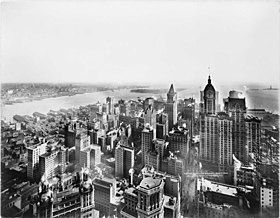
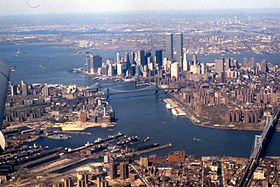
Washington Market was located between Barclay and Hubert Streets, and from Greenwich Street to West Street.[27] It was demolished in the 1960s and replaced by a new Independence Plaza, Washington Market Park and other developments.
Lower Manhattan retains one of the most irregular street grid plans in the borough. Throughout the early decades of the 1900s, the area experienced a construction boom, with major towers such as 40 Wall Street, the American International Building, Woolworth Building, and 20 Exchange Place being erected.
On March 25, 1911, the Triangle Shirtwaist Factory fire in Greenwich Village took the lives of 146 garment workers, which would eventually lead to great advancements in the city's fire department, building codes, and workplace regulations.
Throughout the first half of the 20th century, the city became a world center for industry, commerce, and communication. Interborough Rapid Transit (the first New York City Subway company) began operating in 1904. The area's demographics stabilized, labor unionization brought new protections and affluence to the working class, the city's government and infrastructure underwent a dramatic overhaul under Fiorello La Guardia, and his controversial parks commissioner, Robert Moses, ended the blight of many tenement areas, expanded new parks, remade streets, and restricted and reorganized zoning controls, especially in Lower Manhattan.
In the 1950s, a few new buildings were constructed in Lower Manhattan, including an 11-story building at 156 William Street in 1955.[28] A 27-story office building at 20 Broad Street, a 12-story building at 80 Pine Street, a 26-story building at 123 William Street, and a few others were built in 1957.[28] By the end of the decade, Lower Manhattan had become economically depressed, in comparison with Midtown Manhattan, which was booming. David Rockefeller spearheaded widespread urban renewal efforts in Lower Manhattan, beginning with constructing One Chase Manhattan Plaza, the new headquarters for his bank. He established the Downtown-Lower Manhattan Association (DLMA) which drew up plans for broader revitalization of Lower Manhattan, with the development of a world trade center at the heart of these plans. The original DLMA plans called for the "world trade center" to be built along the East River, between Old Slip and Fulton Street. After negotiations with New Jersey Governor Richard J. Hughes, the Port Authority decided to build the World Trade Center on a site along the Hudson River and the West Side Highway, rather than the East River site.[citation needed]
When building the World Trade Center, 1.2 million cubic yards (917,000 m3) of material was excavated from the site.[29] Rather than dumping the spoil at sea or in landfills, the fill material was used to expand the Manhattan shoreline across West Street, creating Battery Park City.[30] The result was a 700-foot (210-m) extension into the river, running six blocks or 1,484 feet (452 m), covering 92 acres (37 ha), providing a 1.2-mile (1.9 km) riverfront esplanade and over 30 acres (12 ha) of parks.[31]
Through much of its history, the area south of Chambers Street was mainly a commercial district, with a small population of residents—in 1960, it was home to about 4,000.[32] Construction of Battery Park City, on landfill from construction of the World Trade Center, brought many new residents to the area. Gateway Plaza, the first Battery Park City development, was finished in 1983. The project's centerpiece, the World Financial Center, consists of four luxury highrise towers. By the turn of the century, Battery Park City was mostly completed, with the exception of some ongoing construction on West Street. Around this time, Lower Manhattan reached its highest population of business tenants and full-time residents.[citation needed]
In 1993, the Downtown Lower Manhattan Association (D-LMA), led by Robert Douglass, contributed to a city Planning Department plan calling for the revitalization of Lower Manhattan. The plan included recommended zoning changes, tax incentives to encourage new tenants and the conversion of commercial buildings into apartments. It also called for the creation of a “business improvement district”, The Alliance for Downtown New York, to help spur the area's renewal. Between 1995 and 2014, 15.8 million square feet of office space has been converted to residential or hotel use. As a result, Lower Manhattan's residential population rose from 14,000 to 60,000.[33]

The Stonewall riots were a series of spontaneous, violent demonstrations by members of the gay community against a police raid that took place in the early morning hours of June 28, 1969, at the Stonewall Inn in the Greenwich Village neighborhood of Lower Manhattan. They are widely considered to constitute the single most important event leading to the gay liberation movement[34][37][38][39] and the modern fight for LGBT rights.[40][41]
Since the early twentieth century, Lower Manhattan has been an important center for the arts and leisure activities. Greenwich Village was a locus of bohemian culture from the first decade of the century through the 1980s. Several of the city's leading jazz clubs are still located in Greenwich Village, which was also one of the primary bases of the American folk music revival of the 1960s. Many art galleries were located in SoHo between the 1970s and early 1990s; today, the downtown Manhattan gallery scene is centered in Chelsea. From the 1960s onward, Lower Manhattan has been home to many alternative theater companies, constituting the heart of the Off-Off-Broadway community. Punk rock and its derivatives emerged in the mid-1970s largely at two venues: CBGB on the Bowery, the western edge of the East Village, and Max's Kansas City on Park Avenue South. At the same time, the area's surfeit of reappropriated industrial lofts played an integral role in the development and sustenance of the minimalist composition, free jazz, and disco/electronic dance music subcultures. The area's many nightclubs and bars—though mostly shorn of the freewheeling iconoclasm, pioneering spirit, and do-it-yourself mentality that characterized the pre-gentrification era—still draw patrons from throughout the city and the surrounding region. In the early twenty-first century, the Meatpacking District, once the sparsely populated province of after-hours BDSM clubs and transgender prostitutes, gained a reputation as New York's trendiest neighborhood.[42]
21st century
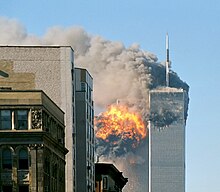
During the September 11 attacks in 2001, two of four hijacked planes were flown into the Twin Towers of the original World Trade Center, and the towers collapsed. The 7 World Trade Center was not struck by a plane but collapsed because of heavy debris falling from the impacts of planes and the collapse of the North Tower. The other buildings of the World Trade Center complex were damaged beyond repair and soon after demolished. The collapse of the Twin Towers caused extensive damage to surrounding buildings and skyscrapers in Lower Manhattan. A total of 2,753 people, including those on the planes, were killed in New York.[43] About 400,000 people, including rescue workers and residents of the area were exposed to toxic dust and debris; many developed serious respiratory illnesses, cancers, and other harms arising from the attack, and 3,496 died.[44]
Following September 11, Lower Manhattan lost much of its economy and office space but has since rebounded significantly. Private sector employment reached 233,000 at the end of 2016, the highest levels since the end of 2001. This was largely due to growth and diversification in the local workforce with gains in employment sectors like Technology, Advertising, Media and Information, as well as Hotel, Restaurants, Retailing, and Health care.[45] As of 2016, Lower Manhattan's business district is home to approximately 700 retail stores and 500 bars and restaurants.[46]
The Lower Manhattan Development Corporation has consummated plans to rebuild downtown Manhattan by adding new streets, buildings, and office space. The National September 11 Memorial at the site was opened to the public on September 11, 2011, while the National September 11 Museum was officially inaugurated by President Barack Obama on May 15, 2014.[47] As of the time of its opening in November 2014, the new One World Trade Center, formerly known as the Freedom Tower, is the tallest skyscraper in the Western Hemisphere[48] and the sixth-tallest in the world, at 1,776 feet (541 m);[49] while other skyscrapers are under construction at the site.
The Occupy Wall Street protests in Zuccotti Park, formerly known as Liberty Plaza Park, began in the Financial District on September 17, 2011, receiving global attention and spawning the Occupy movement against social and economic inequality worldwide.[50]
On October 29 and 30, 2012, Hurricane Sandy ravaged portions of Lower Manhattan with record-high storm surge from New York Harbor, severe flooding, and high winds, causing power outages for hundreds of thousands of Manhattanites and leading to gasoline shortages and disruption of mass transit systems. The storm and its effects have prompted the discussion of constructing seawalls and other coastal barriers around the shorelines of Manhattan and the New York City metropolitan region to minimize the risk of destructive consequences from another such event in the future.[51]
Lower Manhattan has been experiencing a baby boom, well above the overall birth rate in Manhattan, with the area south of Canal Street witnessing 1,086 births in 2010, 12% greater than 2009 and over twice the number born in 2001.[52] The Financial District alone has witnessed growth in its population to approximately 43,000 as of 2014, nearly double the 23,000 recorded at the 2000 Census.[53]
There are currently 61,000 residents south of Chambers Street[54] and more than 62 percent of the population is between 18 and 44. Lower Manhattan is home to more young professionals than Greenpoint, the East Village, and Downtown Brooklyn and on par with Downtown Jersey City and Williamsburg.[55]
In June 2015, The New York Times wrote that Lower Manhattan's dining scene was experiencing a renaissance.[56] Currently, there are 416 casual dining and 129 full-service dining restaurants.[57] The Village Voice, based at 80 Maiden Lane in the Financial District and historically the largest alternative newspaper in the United States, announced in 2017 that it would cease publication of its print edition and convert to a fully digital venture.[58]
On October 31, 2017, a man drove a pickup truck into the Hudson River Park's bike path between Houston Street and Chambers Street, killing eight people and injuring at least 15.[59] Most of those who were hit were bicyclists. It was the first deadly terrorist attack in Manhattan since 9/11.[60][61]
Since 2010, a Little Australia has emerged and is growing in the Nolita neighborhood of Lower Manhattan.[62]
Historical sites
This section needs additional citations for verification. (April 2019) |
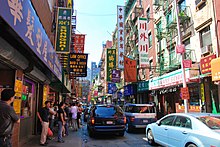
Before the September 11 attacks, the Twin Towers were iconic of Lower Manhattan's global significance as a financial center. The new office towers built since the attack (including One World Trade Center) have transformed the skyline of Lower Manhattan. The 9/11 Memorial & Museum at the former World Trade Center site has become a popular draw for visitors.
The area contains many historical buildings and sites, including Castle Garden, originally the fort Castle Clinton, Bowling Green, the old United States Customs House, now the National Museum of the American Indian, Federal Hall National Memorial, where George Washington was inaugurated as the first U.S. President, Fraunces Tavern, New York City Hall, the Museum of American Finance, the New York Stock Exchange, renovated original mercantile buildings of the South Street Seaport (and a modern tourist building), the Brooklyn Bridge, South Ferry, embarkation point for the Staten Island Ferry, and Trinity Church. Lower Manhattan is home to some of New York City's most spectacular skyscrapers, including the Woolworth Building, 40 Wall Street (also known as the Trump Building), the Standard Oil Building at 26 Broadway, and the American International Building.
Among the commercial districts of Lower Manhattan no longer in existence was Radio Row on Cortlandt Street, which was demolished in 1966 to make way for construction of the former World Trade Center.
Denotation

Downtown in the context of Manhattan, and of New York City generally, has different meanings to different people, especially depending on where in the city they reside. Residents of the island or of The Bronx generally speak of going "downtown" to refer to any southbound excursion to any Manhattan destination.[65] A declaration that one is going to be "downtown" may indicate a plan to be anywhere south of 14th Street—the definition of downtown according to the city's official tourism marketing organization[65]—or even 23rd Street.[66][67] The full phrase Downtown Manhattan may also refer more specifically to the area of Manhattan south of Canal Street.[32] Within business-related contexts, many people use the term Downtown Manhattan to refer only to the Financial District and the corporate offices in the immediate vicinity. For instance, the Business Improvement District managed by the Alliance for Downtown New York defines Downtown as south of Murray Street (essentially South of New York City Hall), which includes the World Trade Center area and the Financial District. The phrase Lower Manhattan may apply to any of these definitions: the broader ones often if the speaker is discussing the area in relation to the rest of the city; more restrictive ones, again, if the focus is on business matters or on the colonial and early post-colonial history of the island.[citation needed]

As reflected in popular culture, "Downtown" in Manhattan has historically represented a place where one could "forget all your troubles, forget all your cares, and go Downtown," as the lyrics of Petula Clark's 1964 hit "Downtown" celebrate (although Tony Hatch, the songwriter of the track, later clarified that he naively believed Times Square to be "downtown," and was the actual inspiration for the hit single). The protagonist of Billy Joel's 1983 hit "Uptown Girl" contrasts himself (a "downtown man") with the purportedly staid uptown world.[68] Likewise, the chorus of Neil Young's 1995 single "Downtown" urges "Let's have a party, downtown all right."
Economy
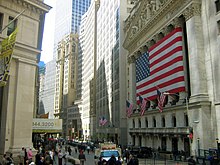
Lower Manhattan is the fourth largest business district in the United States, after Midtown Manhattan, the Chicago Loop, and Washington, D.C.[72] Anchored by Wall Street, New York City functions as the financial capital of the world and has been called the world's most economically powerful city.[73][74][75][76] Lower Manhattan is home to the New York Stock Exchange, on Wall Street, and the corporate headquarters of NASDAQ, at 165 Broadway, representing the world's largest and second largest stock exchanges, respectively, when measured both by overall average daily trading volume and by total market capitalization of their listed companies in 2013.[77] Wall Street investment banking fees in 2012 totaled approximately US$40 billion.[78][79]
Other large companies with headquarters in Lower Manhattan include, in alphabetical order:
- AIG, 175 Water Street[80]
- Ambac Financial Group[81]
- AOL, at 770 Broadway[82]
- BARKER, 30 Broad Street[83]
- Condé Nast, One World Trade Center, publisher of Vogue, W, Vanity Fair, The New Yorker, among others[84]
- EmblemHealth and Standard & Poor's, at 55 Water Street[85][86] HIP Health Plan of New York, which became a part of EmblemHealth, moved there with 2,000 employees in October 2004. It was the largest corporate relocation in downtown Manhattan following the September 11 attacks.[87]
- Goldman Sachs, at 200 West Street
- Group M, 3 World Trade Center[88]
- Hudson's Bay Company, Brookfield Place, the parent company of Saks, Lord and Taylor and Gilt Groupe[89]
- IBT Media, publisher of the International Business Times and Newsweek, among other publications; located in Hanover Square
- Nielsen Company and subsidiary Nielsen Media Research[90][91]
- PR Newswire, at 350 Hudson Street[92]
- Spotify, 4 World Trade Center[93]
- Verizon Communications, at 140 West Street[94]
Prior to the September 11 attacks, One World Trade Center served as the headquarters of Cantor Fitzgerald.[95] Prior to its dissolution, the headquarters of US Helicopter were in Lower Manhattan.[96] When Hi Tech Expressions existed, its headquarters were in Lower Manhattan.[97][98]
Government and infrastructure
The headquarters of the Port Authority of New York and New Jersey is located in Four World Trade Center of the World Trade Center complex.[99]
The city hall and related government infrastructure of the City of New York are located in Lower Manhattan, next to City Hall Park. The Jacob K. Javits Federal Building is located in Civic Center. It includes the Federal Bureau of Investigation New York field office.[100]
Many New York City Subway routes converge downtown. The largest hub, Fulton Center, was completed in 2014 after a $1.4 billion reconstruction project necessitated by the September 11, 2001 attacks, and involves six separate stations. This transit hub was expected to serve 300,000 daily riders as of late 2014.[101] The World Trade Center Transportation Hub and PATH station opened in 2016.[102] Ferry services are also concentrated downtown, including the Staten Island Ferry at the Whitehall Terminal, NYC Ferry at Pier 11/Wall Street (and Battery Park City Ferry Terminal starting in 2020), and service to Governors Island at the Battery Maritime Building.
Many MTA express buses stop in lower Manhattan, the SIM1, SIM2, SIM4, SIM5, SIM7, SIM9, SIM15, SIM32, SIM33, SIM34, and SIM35 to Staten Island, the BM1, BM2, BM3, BM4, X27, and X28 to Brooklyn, the QM7, QM8, QM11, and QM25 to Queens, and the BxM18 to The Bronx
See also
References
- ^ "Manhattan, New York – Some of the Most Expensive Real Estate in the World Overlooks Central Park". The Pinnacle List. Archived from the original on November 29, 2014. Retrieved November 24, 2014.
- ^ Pisani, Bob (May 18, 2018). "New 3 World Trade Center to mark another step in NYC's downtown revival". CNBC. Retrieved May 18, 2018.
- ^ Hughes, C. J. (August 8, 2014). "The Financial District Gains Momentum". The New York Times. Retrieved August 14, 2014.
- ^ "District Information". Downtown Alliance. Retrieved August 16, 2017.
- ^ "United States History – History of New York City, New York". Online Highways LLC. Retrieved July 20, 2014 – via www.u-s-history.com.
- ^ Rankin, Rebecca B.; Rodgers, Cleveland (1948). New York: the World's Capital City, Its Development and Contributions to Progress. Harper.
- ^ a b "The Battery Highlights : NYC Parks". New York City Department of Parks and Recreation. Retrieved 2019-03-02.
- ^ a b Ellis, Edward Robb (1966). The Epic of New York City. Old Town Books.
- ^ Scheltema, Gajus and Westerhuijs, Heleen (eds.),Exploring Historic Dutch New York. Museum of the City of New York/Dover Publications, New York 2011.
- ^ Schoolcraft, Henry L. (1907). "The Capture of New Amsterdam". English Historical Review. 22 (88): 674–693. doi:10.1093/ehr/XXII.LXXXVIII.674. JSTOR 550138.
- ^ Homberger, Eric (2005). The Historical Atlas of New York City: A Visual Celebration of 400 Years of New York City's History. Owl Books. p. 34. ISBN 0-8050-7842-8.
- ^ a b Harris, Leslie M. (2003). In the Shadow of Slavery: African Americans in New York City, 1626-1863. The University of Chicago Press. ISBN 978-0226317731.
- ^ Spencer P.M. Harrington, "Bones and Bureaucrats", Archeology, March/April 1993, accessed February 11, 2012.
- ^ Rothstein, Edward (February 26, 2010). "A Burial Ground and Its Dead Are Given Life". The New York Times. Archived from the original on March 2, 2010. Retrieved March 1, 2010.
- ^ "Gotham Center for New York City History" Archived 2008-12-29 at the Stanford Web Archive Timeline 1700–1800.
- ^ "The Hidden History of Slavery in New York". The Nation. Retrieved February 11, 2008.
- ^ Rothstein, Edward (February 26, 2010). "A Burial Ground and Its Dead Are Given Life". The New York Times. Retrieved March 1, 2010.
- ^ Morison, Samuel Eliot (1972). The Oxford History of the American People. New York City: Mentor Books. p. 207. ISBN 0-451-62600-1.
- ^ Moore, Nathaniel Fish (1876). An Historical Sketch of Columbia College, in the City of New York, 1754–1876. Columbia College. p. 8.
- ^ "A Public Market for Lower Manhattan" (PDF). New York City Council.
- ^ "The People's Vote: President George Washington's First Inaugural Speech (1789)". U.S. News and World Report. Archived from the original on September 25, 2008. Retrieved May 28, 2007.
- ^ Bridges, William (1811). Map of the City of New York and Island of Manhattan with Explanatory Remarks and References.
- ^ Lankevich (1998), pp. 67–68.
- ^ Cudahy, Brian J. (1990). Over and Back: The History of Ferryboats in New York Harbor. Fordham University Press. p. 25. ISBN 0-8232-1245-9.
- ^ The 100 Year Anniversary of the Consolidation of the 5 Boroughs into New York City, New York City. Retrieved June 29, 2007.
- ^ Jackson, Kenneth (1995). Encyclopedia of New York City. New Haven: Yale University Press. p. 206. "[B]orough presidents ... responsible for local administration and public works."
- ^ Millstein, Gilbert (April 24, 1960). "Restless Ports for the City's Food". The New York Times.
- ^ a b Bartnett, Edmond J. (December 25, 1960). "Building Activity Soars Downtown". The New York Times.
- ^ Gillespie, Angus K. (1999). Twin Towers: The Life of New York City's World Trade Center. Rutgers University Press. p. 71. ISBN 0-7838-9785-5.
- ^ Iglauer, Edith (November 4, 1972). "The Biggest Foundation". The New Yorker.
- ^ ASLA 2003 The Landmark Award, American Society of Landscape Architects. Accessed May 17, 2007.
- ^ a b Brown, Charles H. (January 31, 1960). "'Downtown' Enters a New Era". The New York Times.
- ^ "Lower Manhattan Real Estate Year In Review 2014". Downtown Alliance. 2014. Retrieved August 25, 2017.
- ^ a b Goicichea, Julia (August 16, 2017). "Why New York City Is a Major Destination for LGBT Travelers". The Culture Trip. Retrieved February 2, 2019.
- ^ "Workforce Diversity The Stonewall Inn, National Historic Landmark National Register Number: 99000562". National Park Service, U.S. Department of the Interior. Retrieved May 1, 2011.
- ^ Rosenberg, Eli (June 24, 2016). "Stonewall Inn Named National Monument, a First for the Gay Rights Movement". The New York Times. Retrieved June 25, 2016.
- ^ "Brief History of the Gay and Lesbian Rights Movement in the U.S." University of Kentucky. Retrieved September 2, 2017.
- ^ Nell Frizzell (June 28, 2013). "Feature: How the Stonewall riots started the LGBT rights movement". Pink News UK. Retrieved August 31, 2017.
- ^ "Stonewall riots". Encyclopædia Britannica. Retrieved August 31, 2017.
- ^ U.S. National Park Service (October 17, 2016). "Civil Rights at Stonewall National Monument". Department of the Interior. Retrieved August 31, 2017.
- ^ "Obama inaugural speech references Stonewall gay-rights riots". Archived from the original on May 30, 2013. Retrieved July 2, 2013.
- ^ Steinberg, Jon (August 18, 2004). "Meatpacking District Walking Tour". New York. Retrieved March 7, 2008.
- ^ "September 11 Terror Attacks Fast Facts". CNN. September 18, 2020.
- ^ "Sept. 11 attacks are still killing first responders 19 years later". KTRK-TV. September 11, 2020.
- ^ "Retail Leads Lower Manhattan Real Estate Activity in 2016". Downtown Alliance. February 7, 2017. Retrieved August 16, 2017.
- ^ "2017 Retail Market Guide". Downtown Alliance. November 2016. Retrieved August 16, 2017.
- ^ "Long delayed Sept 11 Memorial Museum inaugurated by Obama". Mainstream Media EC. May 15, 2014. Retrieved December 7, 2014.
- ^ DeGregory, Priscilla (November 3, 2014). "1 World Trade Center is open for business". New York Post. Retrieved November 24, 2014.
- ^ Katia Hetter (November 12, 2013). "It's official: One World Trade Center to be tallest U.S. skyscraper". CNN. Retrieved November 12, 2013.
- ^ "OccupyWallStreet - About". Occupy Wall Street. Retrieved July 20, 2014.
- ^ Eshelman, Robert S. (November 15, 2012). "Adaptation: Political support for a sea wall in New York Harbor begins to form". E&E Publishing. Retrieved December 2, 2012.
- ^ Shapiro, Julie (January 11, 2012). "Downtown Baby Boom Sees 12 Percent Increase in Births". DNAinfo New York. Archived from the original on October 20, 2014. Retrieved August 4, 2013.
- ^ C. J. Hughes (August 8, 2014). "The Financial District Gains Momentum". The New York Times. Retrieved August 14, 2014.
- ^ "Residential Pipeline 2Q 2017". Downtown Alliance. Retrieved August 17, 2017.
- ^ "Downtown Is Home to as Many Young Professionals as Williamsburg: Report". DNAinfo. October 13, 2016. Archived from the original on August 18, 2017. Retrieved August 17, 2017.
- ^ Gordinier, Jeff (June 23, 2015). "Manhattan's Dining Center of Gravity Shifts Downtown". The New York Times. Retrieved June 24, 2015.
- ^ "Map of Lower Manhattan". Downtown Alliance. Retrieved August 25, 2017.
- ^ Leland, John; Maslin Nir, Sarah (August 22, 2017). "After 62 Years and Many Battles, Village Voice Will End Print Publication". The New York Times. Retrieved September 2, 2017.
- ^ Helsel, Phil; Winter, Tom (October 31, 2017). "Terrorism suspected after Truck Driver Kills Six in Lower Manhattan". NBC News. NBCUniversal. Retrieved October 31, 2017.
- ^ Mueller, Benjamin; K. Rashbaum, WIilliam (October 31, 2017). "Multiple Deaths Reported as Driver Careens Down Bike Path in Manhattan". The New York Times. Retrieved October 31, 2017.
- ^ Bryant, Nick (October 31, 2017). "New York attack: At least six killed by man driving truck". BBC News. Retrieved October 31, 2017.
- ^ Shaun Busuttil (November 3, 2016). "G-day! Welcome to Little Australia in New York City". KarryOn. Retrieved May 24, 2019.
In Little Australia, Australian-owned cafes are popping up all over the place (such as Two Hands), joining other Australian-owned businesses (such as nightclubs and art galleries) as part of a growing green and gold contingent in NYC. Indeed, walking in this neighbourhood, the odds of your hearing a fellow Aussie ordering a coffee or just kicking back and chatting are high – very high – so much so that if you're keen to meet other Aussies whilst taking your own bite out of the Big Apple, then this is the place to throw that Australian accent around like it's going out of fashion!
- ^ Sarah Waxman. "The History of New York's Chinatown". Mediabridge Infosystems, Inc. Retrieved July 20, 2014.
Manhattan's Chinatown, the largest Chinatown in the United States and the site of the largest concentration of Chinese in the Western Hemisphere, is located on the Lower East Side.
- ^ "Chinatown New York City Fact Sheet" (PDF). explorechinatown.com. Retrieved July 20, 2014.
- ^ a b NYC Basics, NYCvisit.com. Retrieved on December 2, 2007.
- ^ Hotels: Downtown below 23rd Street Archived 2007-11-20 at the Wayback Machine, Time Out New York. Retrieved December 3, 2007.
- ^ "Residents Angered By Bar Noise In Downtown Manhattan" Archived 2006-07-17 at the Wayback Machine, NY1 News, March 3, 2006. Retrieved on December 3, 2007.
- ^ Downtown: Its Rise and Fall, 1880–1950 by Professor Robert M Fogelson. Yale University Press, 2003. ISBN 0-300-09827-8. pg 3
- ^ "The NYSE Makes Stock Exchanges Around The World Look Tiny". Business Insider. Retrieved March 26, 2017.
- ^ "Is the New York Stock Exchange the Largest Stock Market in the World?". Zacks. Retrieved March 26, 2017.
- ^ "Largest stock exchange operators worldwide as of April 2018, by market capitalization of listed companies (in trillion U.S. dollars)". Statista. Retrieved February 18, 2019.
- ^ "Lower Manhattan". New York City Economic Development Corporation. Retrieved March 31, 2014.
- ^ Huw Jones (January 27, 2020). "New York surges ahead of Brexit-shadowed London in finance: survey". Reuters. Retrieved January 27, 2020.
New York remains the world's top financial center, pushing London further into second place as Brexit uncertainty undermines the UK capital and Asian centers catch up, a survey from consultants Duff & Phelps said on Monday.
- ^ Jones, Huw (September 4, 2018). "United States top, Britain second in financial activity: think-tank". Thomson Reuters. Retrieved September 4, 2018.
Think-tank New Financial's study, which focuses on the "raw" value of actual domestic and international financial activity like managing assets and issuing equity, underscored the overall dominance of New York as the world's top financial center.
- ^ Florida, Richard (March 3, 2015). "Sorry, London: New York Is the World's Most Economically Powerful City". The Atlantic Monthly Group. Retrieved March 16, 2015.
Our new ranking puts the Big Apple firmly on top.
- ^ [1] Accessed September 26, 2020.
- ^ "2013 WFE Market Highlights" (PDF). World Federation of Exchanges. Archived from the original (PDF) on March 27, 2014. Retrieved July 20, 2014.
- ^ Choudhury, Ambereen; Martinuzzi, Elisa; Moshinsky, Ben (November 26, 2012). "London Bankers Bracing for Leaner Bonuses Than New York". Bloomberg L.P. Retrieved July 20, 2014.
- ^ "Lower Manhattan's Hotel Market Diversifies as Mid-Priced Options Expand". Downtown Alliance. Retrieved August 25, 2017.
- ^ "Company Overview of American International Group, Inc". Bloomberg L.P. Retrieved April 24, 2018.
- ^ "Contact Us." Ambac Financial Group. Retrieved on December 11, 2009.
- ^ "Company Overview Archived 2009-02-18 at the Wayback Machine." AOL. Retrieved on May 7, 2009.
- ^ "Madison Avenue Is Moving To Wall Street". Business Insider. January 24, 2014. Retrieved August 17, 2017.
- ^ "Condé Nast Moves Into the World Trade Center as Lower Manhattan Is Remade". The New York Times. November 2, 2014. Retrieved August 17, 2017.
- ^ "Office Locations". Standard & Poor's. Retrieved on August 12, 2011. "Corporate 55 Water Street New York New York"
- ^ "Large Employer Group Application Archived 2013-05-12 at the Wayback Machine". EmblemHealth. Retrieved on August 12, 2011. "EmblemHealth, 55 Water Street, New York, New York 10041 HIP Insurance Company of New York, 55 Water Street, New York, NY 10041 Group Health Incorporated, 441 Ninth Avenue, New York, NY 10001"
- ^ "HIP Celebrates Opening of New Headquarters in Lower Manhattan Relocation of 2,000 Employees to 55 Water Street Represents Largest Corporate Relocation to Lower Manhattan Since 9/11 Archived 2014-10-13 at the Wayback Machine". HIP Health Plan. October 12, 2004. Retrieved on August 12, 2011.
- ^ "Media agency GroupM completes deal to expand at 3 WTC". Crain's New York. January 5, 2016. Retrieved August 17, 2017.
- ^ "Saks Embraces Lower Manhattan". The New York Times. September 4, 2014. Retrieved August 17, 2017.
- ^ "Univision sues over Nielsen's meters." Associated Press at the St. Petersburg Times. June 11, 2004. Retrieved on August 28, 2011. "New York is the corporate headquarters of Nielsen,[...]"
- ^ "Contact Us Archived 2011-08-29 at the Wayback Machine." Nielsen Company. Retrieved on August 28, 2011. "The Nielsen Company, 770 Broadway, New York, NY 10003-9595"
- ^ ""Archived copy". PR Newswire. Archived from the original on July 26, 2014. Retrieved July 20, 2014.
{{cite news}}: CS1 maint: archived copy as title (link) - ^ "Spotify signs massive lease at 4 World Trade Center". New York Post. February 15, 2017. Retrieved August 17, 2017.
- ^ [2]. Verizon Corporate Office Headquarters. Retrieved on July 30, 2014.
- ^ "office locations." Cantor Fitzgerald. March 4, 2000. Retrieved on October 4, 2009.
- ^ "Contact Us." US Helicopter. Retrieved on September 25, 2009.
- ^ Ward's Business Directory of U.S. Private and Public Companies, 1995: Alphabetic listing, G-O Volume 2. Gale Research, 1995. "2073. Retrieved from Google Books on July 28, 2010. "Hi Tech Expressions Inc. 584 Broadway New York, NY 10012." ISBN 0-8103-8831-6, ISBN 978-0-8103-8831-4.
- ^ "Playin fair video-game manufacturers target an untapped market -- Girls". Pittsburgh Post-Gazette. June 12, 1994. K-1. Retrieved on July 28, 2010. "Meanwhile, over at Hi Tech Expressions, a New York-based software company".
- ^ "About the Port Authority." Port Authority of New York and New Jersey. June 22, 2000. Retrieved on January 22, 2010.
- ^ "New York Field Office." Federal Bureau of Investigation. Retrieved on June 9, 2015. "26 Federal Plaza, 23rd Floor New York, NY 10278-0004"
- ^ "Biggest NY Subway Hub Opens; Expects 300,000 Daily". ABC News. December 10, 2014. Retrieved November 18, 2014.
- ^ "World Trade Center transportation hub, dubbed Oculus, opens to public". ABC7 New York. March 3, 2016. Retrieved July 8, 2018.

